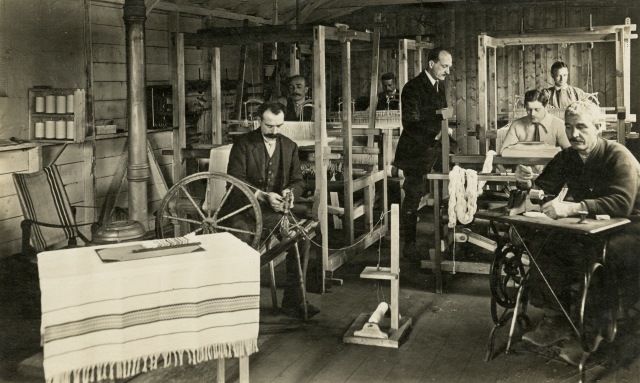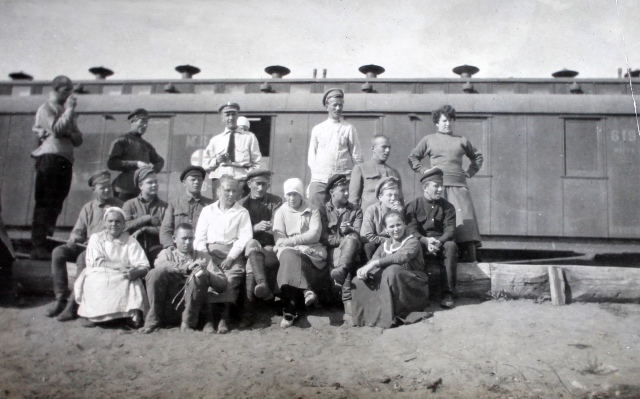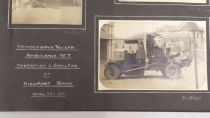When our project cataloguer came across a cockade (a type of ribbon rosette for wearing on a hat or pinned to a garment) from 1792 revolutionary France among the A. Ruth Fry papers (TEMP MSS 373), belonging to John Hodgkin (1766-1845), we wondered what involvement Quakers had with the French Revolution. Quite a bit, it turns out, and with cockades themselves in particular!

Tricolour cockade, revolutionary France, 1791, Benjamin Angell papers, (Library reference: TEMP MSS 58/8)
Quakers in France The story of French Quakerism is an interesting one. A group emerged in the Cévennes region of France around the time of the Camisard War (1702-1704), who chose to use nonviolence even in defence from brutal oppression. Known as the Inspirés du Languedoc, they later picked up the name Couflaïres, which in Provençal means ‘inflated by the Spirit’. Couflaïres worshipped in silence and had no appointed ministers, yet had never come into contact with Quakerism. They lived mainly in Congénies, Sommières, Saint Gilles, Fontanès, Aujargues, Calvisson, and Codognan. In 1785 contact was made between British Quakers and this group in France. One of the French group, Jean de Marsillac, was invited to meet British Friends. This visit, and several more, proved fruitful, and in 1788 the first group of British Friends went to visit Congénies. On this occasion, the French group were invited officially to join the Society of Friends. Around the same time, a group of Nantucket Quakers, led by William Rotch, had moved to Dunkirk and joined the French Friends in Congénies. Jeanne Henriette Louis called William Rotch “the most influential figure on Nantucket during the American Revolution”.[1] Rotch had led Nantucket Quakers in nonviolence and neutrality through the War of Independence and the Revolution, but felt they had to leave in search of better fortune, and ended up in Dunkirk. Quakers in revolutionary France An article by Peter Brock on conscientious objection in revolutionary France (Journal of the Friends Historical Society, vol. 57, no. 2, 1995)[2] sheds some light on French Quaker attitudes to the Revolution, and in particular to the levée en masse, a form of conscription for the army of the new French Republic. Brock remarks on the long held respect for Quakerism among the leading thinkers of the French Revolution, who viewed Penn’s experiment in Pennsylvania as an almost utopian ideal for society. He specifically mentions Jacques-Pierre Brissot de Warville, one of the most prominent Girondin leaders, who had formed a close relationship with French and English Quakers. Indeed a handwritten note accompanying one of the two revolutionary cockades in our collection reads: “Tricolor Cockades. brought by John Hodgkin from Paris in 1792. He himself wore one by advice of Brissot, the Girondist on the occasion of the Federation, in the Champs de Mars” (TEMP MSS 373/B1/5)

John Hodgkin’s tricolour cockade and note in A. Ruth Fry papers (Library reference: TEMP MSS 373 B1/5)
Brissot was in contact with Quakers as an abolitionist; his group, the Société des Amis des Noirs, was inspired by the English Quakers’ anti-slavery activities. He also wrote that Quakers should be invited to revolutionary France, as they had the same aims as the revolutionaries – liberty, equality and brotherhood, albeit desiring to achieve them through different, peaceful means: “We are all striving for the same object, universal fraternity; the Quakers by gentleness, we by resistance.” (Brissot New travels, quoted in Brock, p.169). As war approached, Marsillac, self-appointed spokesman for Friends in France, wanted to deliver a petition to the National Assembly. He consulted Brissot, amongst other Girondists, in putting together a petition that Brissot thought would gain ground with Mirabeau, the new leader of the Assembly. On 10th February 1791, Marsillac, William Rotch, and Benjamin Rotch took the petition to the National Assembly. They entered the packed room, refusing to remove their hats, in Quaker fashion. They also refused to wear the national cockade, despite being pressed to do so and informed that it was a requirement in law. The Assembly warned them that they would not be able to protect them from mob retaliation if they were seen on the streets without the cockades. Can we assume, from the existence of the cockades in our collections, that the English Quakers were not brave enough to follow their example when they travelled in France? The main thrust of the petition was to gain exemption from military service for Quakers, but also an exemption from taking civic oaths, and permission to carry on their own method of recording births, marriages and deaths. They appealed to the Assembly’s avowed religious tolerance and reminded them that Britain and America had already granted similar liberties to Quakers. They made specific mention of Pennsylvania, probably knowing the attitudes of many of the revolutionaries to Penn’s experiment there. While Mirabeau was respectful and admiring of some of the qualities the Quakers represented, his tone was ultimately lacking in understanding:
“The assembly will discuss all your demands in its wisdom, and if I ever meet a quaker, I’ll say to him, My brother, if thou hast a right of being free, thou hast a right to hinder thyself from being made a slave…”
(Address from the Society of Friends, resident in France, to the National Convention, 2nd of 10th month 1791. To which is subjoined the president’s reply. London: Printed for Edmund Fry, 1825 )

Address from the Society of Friends, resident in France, to the National Convention, 2nd of 10th month 1791, (Library reference: Box 33/35).
Mirabeau declared that having won liberty, all French citizens must be prepared to defend that liberty from tyrants. However the Assembly agreed to consider the petition, and the Quaker petitioners were welcomed into various social circles while in Paris to discuss the issues arising. It seems however that no firm decision was taken before the Assembly’s dissolution. Marsillac was in contact with English Quakers and presented a lukewarm verdict on the treatment of the Quakers by the Assembly. It must have been in this uncertain time for Quakers in France that their English Friends thought it worthwhile to go and show some support. The 1791 Yearly Meeting minute approving a small group of Friends to go over to Dunkirk is brief, and seems aimed at deciding whether the Nantucket Friends at Dunkirk should join the Yearly Meeting in England:
“The said friends are desired to consider whether their junction with any branch of this yearly meeting will be expedient, & if the same shall appear eligible they are authorised to carry the said Junction into effect.” (London Yearly Meeting minutes, 1791 Library ref. YM/M/39)

London Yearly Meeting minutes, 1791 (Library reference: YM/M/39)

London Yearly Meeting minutes, 1791 (Library reference: YM/M/39)
Benjamin Angell was one of the Kent Friends who joined the group appointed by Yearly Meeting and travelled to France. Our collection of his papers (TEMP MSS 58/8) includes one of the cockades, a French passport, and a small travel diary describing their visit. We can presume that, as well as the issue of membership, the matter of the petition to the National Assembly and the wider situation in France must have been discussed by the English and French Friends. Unfortunately Angell’s diary is mainly a factual account of the trip, and more taken up with the town planning of Dunkirk, than conscientious objection and issues of citizenship in the new Republic! It wasn’t until later in 1792 that Marsillac and others wrote of a much worsening situation for French Quakers, including rough treatment for refusal to wear the cockade. Marsillac himself was arrested for not wearing a cockade in public. He writes to an English Friend:
“It has pleased the lord to suffer us to fall under divers tryals, which in our weak state, we have found painful & grievious, the civic oath, the obligation imposed by the National Assembly to mount guard personally & the Arm, & to declare the arms every one had in his Possession, under the pain of being found guilty of treason & punished by Death….I was arrested at Paris because I had not the National Cockade, & signified my reasons for noncompliance, before the Judges of the Peace, & since that, before Petition Mayor of Paris, who had me set at liberty…” (Letter from Jean Marsillac, 10 July 1792, Library ref. MS VOL 314/70)
This letter is from a volume of original manuscripts relating to France held here at the Library, featuring several letters from Jean de Marsillac to English Friends (he drops the aristocratic ‘de’ from his name). We can see then, with the worsening crisis in France and the onset of war, that the Quakers’ petition failed. By 1793, the Dunkirk Quakers had left France for England, after run-ins with the authorities, and in 1795, Marsillac left for America. The whole affair shows an interesting clash of ideologies, with the enlightened basic principles of the French revolutionaries being truly tested by the small band of French Quakers. It is a small episode in the gradual decay of the spirit of the Revolution by years of inward terror and war with other nations. It also demonstrates a close and supportive relationship between the English Quakers and the odd assortment of American Quakers and French ‘Inspirés’ in France, which is evident in the warm correspondence between Marsillac and English Friends in manuscripts in our collection and in the concern shown by English Friends over the French situation in minutes and epistles. [1] Jeanne Henriette Louis, ‘The Nantucket Quakers’ message as an alternative to Benjamin Franklin’s message to the French Revolution’ in Quaker studies: journal of the Quaker Studies Research Association, vol. 5, no.1 (September 2000), p. 10 [2] Peter Brock, ‘Conscientious objection in revolutionary France’ in Journal of the Friends Historical Society, vol.57; no.2 ( 1995), p. 166–82





















![Suffering Armenia [public meeting 1897]](https://librarysocietyfriendsblog.files.wordpress.com/2015/04/box_449-33-e1429794617110.jpg?w=640&h=496)













































